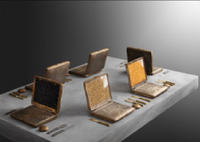Right now, hundreds of thousands of American refugees need our national concern and care. Thousands of people still need to be rescued from imminent peril. Public health threats must be controlled in New Orleans and throughout southern Mississippi. Drivers must be given confidence that gasoline will be available, and profiteering must be brought under control at a moment when television has been showing long lines at some pumps and spot prices approaching $4 a gallon have been reported.
Sacrifices may be necessary to make sure that all these things happen in an orderly, efficient way. But this administration has never been one to counsel sacrifice. And nothing about the president's demeanor yesterday - which seemed casual to the point of carelessness - suggested that he understood the depth of the current crisis.
8.31.2005
Looking for a leader.
Bush may have said what we needed to hear following 9/11, but in the aftermath of Katrina, a hurricane that some say might push us over the top into a recesssion, he delivered "one of the worst speeches of his life," states a New York Times editorial:
The flyover president.
Arianna Huffington:
The president's 35-minute Air Force One flyover of Louisiana, Mississippi, and Alabama was the perfect metaphor for his entire presidency: detached, disconnected, and disengaged. Preferring to take in America's suffering -- whether caused by the war in Iraq or Hurricane Katrina -- from a distance. In this case, 2,500 feet.Read more.
Apparently, the president "sat somberly on a couch on the left hand side of the presidential jumbo jet peering out the window" at the catastrophe below, joined at different times by White House staffers including Karl Rove and Scott McClellan.
McClellan later quoted the president as saying, "It's devastating. It's got to be doubly devastating on the ground." Ya think?? Hey, here's an idea, Mr. President: maybe you should, y'know, get off the plane and see for yourself?
Instead, he jetted on to Washington for a brisk 9-minute Rose Garden speech designed to let us know that his administration was doing everything in its power to mitigate the looming PR disaster the flooding of New Orleans could create for the White House... Uh, I mean, everything in its power to aid the recovery.
The speech contained the usual Bush bonhomie (he's "confident" New Orleans "will be back on its feet, and America will be a stronger place for it"). But the most telling moment came when the president discussed the ways his administration was moving to help ease the suffering of profit-soaked oil companies impacted by the storm, pointing out that he had instructed Energy Secretary Sam Bodman to work with refineries to "alleviate any shortage through loans" and that the EPA had waived clean air standards for gasoline and diesel fuels in all 50 states. You could almost see him getting misty...
New Orleans drowns, Bush strums.
 A hurricane hit the Gulf Coast on Monday. I'm sure you heard, but judging by the president's actions, perhaps he hadn't: he was strumming his guitar on a naval base on Tuesday, and only today has he packed up and headed back to Washington to address the problem. To his credit, Bush did cut his five-week vacation two days short (after giving a speech linking Iraq with 9/11 and World War II).
A hurricane hit the Gulf Coast on Monday. I'm sure you heard, but judging by the president's actions, perhaps he hadn't: he was strumming his guitar on a naval base on Tuesday, and only today has he packed up and headed back to Washington to address the problem. To his credit, Bush did cut his five-week vacation two days short (after giving a speech linking Iraq with 9/11 and World War II). But long before that, he did the real disservice to the people of hurricane-stuck Louisiana: for fiscal 2006, Bush and the GOP cut $71.2 million in federal funding to the New Orleans district of the U.S. Army Corps of Engineers, funds earmarked for hurricane and flood protection projects. At the time, Sen. Mary Landrieu said, "I think it's extremely shortsighted. When the Corps of Engineers' budget is cut, Louisiana bleeds. These projects are literally life-and-death projects to the people of south Louisiana and they are (of) vital economic interest to the entire nation." With New Orleans 80% under water, untold dead, and damage estimates soaring past $25 billion, we'll soon see how right Landrieu, unfortunately, was.
Race and reporting: How come white people find, but black people loot?
The new science.
 First the US Postal Service came out with postage stamps honoring scientists like physicist Richard Feynman and mathematician John von Neumann. Then, in this age of "intelligent design" hucksterism, the spoofers got ahold of 'em. The new version features the likes of Rick Santorum, George W. Bush, and William Jennings Bryan.
First the US Postal Service came out with postage stamps honoring scientists like physicist Richard Feynman and mathematician John von Neumann. Then, in this age of "intelligent design" hucksterism, the spoofers got ahold of 'em. The new version features the likes of Rick Santorum, George W. Bush, and William Jennings Bryan.Earlier: Science trading cards! And, via WiFi Art, Sci-Philately.
In the grid, off the grid.
 A 35-square-block section of Portland, Oregon, may become the country's most sustainable urban neighborhood. While building mid-rise towers for office and retail and creating 8 million square feet of floor space, the Lloyd Crossing development will also reduce net energy and water consumption "to levels nearly equivalent to a patch of native Northwest forest," writes Metropolis. The seven steps the plan calls for:
A 35-square-block section of Portland, Oregon, may become the country's most sustainable urban neighborhood. While building mid-rise towers for office and retail and creating 8 million square feet of floor space, the Lloyd Crossing development will also reduce net energy and water consumption "to levels nearly equivalent to a patch of native Northwest forest," writes Metropolis. The seven steps the plan calls for:1. Carve out bioswales to collect street runoff.
2. Treat wastewater in the neighborhood and reuse gray water.
3. Build according to stringent LEED silver standards.
4. Deploy photovoltaics to supplement power.
5. Turn to wind turbines for energy.
6. Store and share heat in an underground thermal loop.
7. Design new buildings to leverage natural forces. (i.e. windows to maximize solar gain, etc.)
(Via Treehugger.)
And: Where does oil money go? USAToday looks into where your ~$3/gallon at the pump goes, from luxury hotels in Dubai to food programs for Venezuela's poor.
(Thanks, Dad.)
8.30.2005
Hero.
A Japanese teacher, after 34 years of service, may lose her job because, as a pacifist, she refuses to stand and sing the national anthem, which calls for the "eternal reign" of the emperor. Kimiko Nezu has been transferred 4 or 5 times in the past few years, has had her salary temporarily cut, and was suspended for a month for violating a Tokyo school board rule that the anthem (the World War II hymn "Kimigayo") must be respected. "They are trying to weed us out of society," Nezu said. "The pacifists, the people who oppose nationalism in Japan. We are gradually being silenced." But she remains adamant: whatever the punishement, even if it's being transferred to a school two hours from home, "I will never stand for that song, the same one that played when [the Imperial Army was] invading Asia. Never."
Hurricane aid.
 Here's a list of resources that can help direct your donation to the victims of Hurricane Katrina, from the New York Times:
Here's a list of resources that can help direct your donation to the victims of Hurricane Katrina, from the New York Times:Relief Organizations:[Image: Canal Street, New Orleans. By Rick Wilking/Reuters]
Charity Navigator: charitynavigator.orgRed Cross: 1-800-HELP-NOW or https://www.redcross.org
AmeriCares:americares.org
Episcopal Relief & Development: 1-800-334-7626 or http://www.er-d.org/
United Methodist Committee on Relief: 1-800-554-8583 or http://gbgm-umc.org/umcor/emergency/hurricanes/2005/
Salvation Army: 1-800-SAL-ARMY or http://www.salvationarmyusa.org/
Catholic Charities: 1-800-919-9338 or http://www.catholiccharitiesusa.org/
FEMA Charity tips: http://www.fema.gov/rrr/help2.shtm
National Voluntary Organizations Active in Disaster: http://www.nvoad.org/
Louisiana Society for the Prevention of Cruelty to Animals: http://www.la-spca.org/
8.29.2005
Bare honesty.
 At first glance, Frank Cordelle may seem like just another male artist who loves capturing images of nude women. But see his photos and read the testimonials of the women he photographs—and the responses from women who see them—and you'll get the sense his work actually is about loving women, not creating some one-dimensional, sexualized caricature. In The Century Project, Cordelle has been photographing women from birth to age 100. Average women, exceptional women, fat, wrinkly, beautiful, innocent, scarred women.
At first glance, Frank Cordelle may seem like just another male artist who loves capturing images of nude women. But see his photos and read the testimonials of the women he photographs—and the responses from women who see them—and you'll get the sense his work actually is about loving women, not creating some one-dimensional, sexualized caricature. In The Century Project, Cordelle has been photographing women from birth to age 100. Average women, exceptional women, fat, wrinkly, beautiful, innocent, scarred women. He says the project is about "art being able to bridge educational and therapeutic gaps, and perhaps most importantly, to be able to stimulate thought and discussion about subjects that are often taboo in our society: namely nudity and sexuality, violence, health issues, aging, our attitudes toward women in general, and their portrayal in the media in particular." The therapy part is about women who've survived disease or violence or crippling self-doubt, yet find themselves bared in front of his camera in an act some of the women describe as liberating.

The excelllent daily videoblog Minnesota Stories, did a piece on St. Paul filmmaker Elizabeth Hoodecheck who is working on a documentary inspired by the project, called Bare Honesty, and my favorite part of it is when one 21-year old woman looks at a photo of a nude women, age 44, and says, "I see me.. . She has this rage and self-hate inside. The same thing I feel: the binging and the purging."
But not all the images are about healing. As one reviewer described in 1995:
There’s 82 year-old Sibby, smiling and walking in the rain outside her Francestown home, dressed only in a brightly colored umbrella.
"You’d think an older generation of women would feel more of a sense of shame," Sibby says. "But I felt perfectly at ease - we had a very good time."
Journalist death toll exceeds Vietnam.
In 2-1/2 years, the Iraq war has already killed more journalists than died in the entire 20-year Vietnam conflict. Between 1955 and 1975, 63 journalists were killed in Vietnam; so far, 66 reporters or media professionals have died in Iraq, the most recent being a Reuters soundman shot yesterday. According to reports Waleed Khaled was downed by five shots fired by a US sniper. The shooter was detained, then released without charge.
8.28.2005
The invention of the century?
 This is kind of old news by blog standards, but today's New York Times report on the cholera epidemic in Africa reminds me how timely the LifeStraw invention is. The Times writes that the number of recorded cholera cases in West Africa this year is "24,621, with at least 401 deaths in Burkina Faso, Guinea, Guinea-Bissau, Liberia, Mali, Mauritania, Niger and Senegal." The problem with cholera and other diorrhoeal diseases from bacteria like typhoid, cholera, e. coli, and salmonella is that they'd be nearly eradicated if only we all had clean drinking water. Instead, they're the world's biggest killer.
This is kind of old news by blog standards, but today's New York Times report on the cholera epidemic in Africa reminds me how timely the LifeStraw invention is. The Times writes that the number of recorded cholera cases in West Africa this year is "24,621, with at least 401 deaths in Burkina Faso, Guinea, Guinea-Bissau, Liberia, Mali, Mauritania, Niger and Senegal." The problem with cholera and other diorrhoeal diseases from bacteria like typhoid, cholera, e. coli, and salmonella is that they'd be nearly eradicated if only we all had clean drinking water. Instead, they're the world's biggest killer. Enter: the LifeStraw, a 25mm pipe with a filter in it. With no moving parts or power plug, the straw, when sucked, filters out sediment, toxins, and--most important of all--bacteria. And for two bucks, it'll provide clean water for one person for a year. Amazing. As Gil Friend puts it:
Got that folks? Clean water for a year for two bucks! Clean water for the four billion of us at the bottom of the pyramid for $8b a year. (Or just the billion or so of us without access to safe water supplies.) Peanuts, in the scheme of things. Less than 1% of the 2002 (pre-Iraq War) global military budget. (Other stats from our Sense of Proportion Department, courtesy the World Bank: Gross National Income, globally, 2002: $31.7 trillion US (31.5 x 10^12); high income counties, $25.6 T, middle income, $5.06 T, low income countries, $1.07 T)No wonder Gil is wondering if it's the "invention of the century."
Prosthetic iPod.
 Planning a trip to Europe, I started a list of items to pack. The first handful is digital in nature:
Planning a trip to Europe, I started a list of items to pack. The first handful is digital in nature: • A digital camera (which comes with an extra battery pack and memory chip and a plug-in charger),
• An iBook (with its cord, plug, USB mouse, and protective case),
• An iPod (with its cord, earbuds, docking plug, and cute knit sock),
• A cellphone (with two forms of charger), and
• A minidisk recorder (with a microphone, extra MDs, cord, plug, VoIP adaptor, iMic adaptor, and headphones), plus
• European power adaptors for 'em all.
I picture myself, like a new father, tottering toward the departure gate with my luggage and a baby bag in tow filled with all the accessories I'll need should I wish to call/charge/upload/email or otherwise put a layer of interface between me and the world I'm experiencing.
Given the excessiveness of it all, maybe there's one more device I need: a piiPod. Designed by the Dutch sculptor Pii, the piiPod is the size, shape, and feel of Apple's famous mp3 player, only it's constructed of hardwood and is "specially designed to be unable to play music and sound files." The piece is on view September 1–17, along with Pii's installation of 12 bronze laptops filled with genetically modified rice and corn, at London's Spectrum Fine Art.
While the wood iPod might be a symbol of my willing (and blissful) enslavement to mediating technologies, Pii has another message, it seems. He says:
I am trying to make people think about what they are missing out on by spending their free lives and transportation periods—travel—locked into their own musical worlds. People do become addicted and dependent—whether there are really health problems or not. It is a basic part of treatment for any serious addiction to attempt to provide a substitute of some kind.And his grain-filled notebook computers critique the position many westerners take on genetically modified grains: putting grain inside a symbol of our luxury "reminds people of our good fortune to be able to make judgments and have debate on a full tummy"—while we type away on our laptops, pondering the long-term safety of GMOs, people are starving.
To digress a bit: I find his argument simplistic. We already produce enough grain to feed the world without the yield-enhancing boost of genetic engineering; transport is the problem. Further, as a recent report by Third World Network-Africa found, "The answer to Africa’s poverty and food shortage problems does not lie in biotechnology. GM crops do not offer any answers to soil fertility, resistance to genes by pests among other problems faced by the farmers of the three crops. It also clear that biotechnology is not the answer to corruption, declining commodity prices, inequality in land distribution and ownership, income disparities, and armed conflicts which are some of the major cause of poverty/hunger in Africa." (And don't get me started on who really benefits from GMOs.)

But Pii seems to admit that the point of his sculptures is to spark dialogue on these issues, and that's something I can agree with. He says:
I admire the Apple design, but I also find it wonderful that we have a piece of technology here that is also named after a source of physical sustenance and food—while we use Apple computers in the west, people elsewhere have no fruit to survive. This is not the fault of Apple Computers, but should certainly encourage people to think.[Cross-posted at Off-Center.]
American Apparel spoof
 At last American Apparel—a good idea (sweatshop-free US-made t-shirts) made bad by the porny marketing and pervy exploits of its founder—gets its own spoof ad. Stay Free! has more. (Click image for larger version.)
At last American Apparel—a good idea (sweatshop-free US-made t-shirts) made bad by the porny marketing and pervy exploits of its founder—gets its own spoof ad. Stay Free! has more. (Click image for larger version.)
The wrath of Google.
Is Google the new Microsoft? I just Googled that phrase, having remembered an article with that name from a few days ago. Such is the case with the ubiquitous Google; it's so engrained in our lives that where else would I go to find information critical of Google?
But when CNET's Eleanor Mills did a not-so-critical and innocuously titled story, "Google balances privacy, reach," Google's CEO wasn't so pleased. Mills spent a half hour seeing what the search engine would churn up on CEO Eric Schmidt and then published it in a balanced piece on the technolgy news site. Nothing earthshattering: Schmidt's loaded, lives in a posh community, gets off on Burning Man and amateur flying. But in response to the article, Schmidt--the guy whose very loadedness comes from putting this type of personal information about you and me out there for the world to see--had a cow. Reacting "in a way better suited to a 16th-century monarchy than a 21st-century democracy with an independent press," Schmidt had his PR director put in a complaint to CNET and banned them from any interviews for a year. So maybe Google is becoming as weird and secretive and dominant as Microsoft...
But when CNET's Eleanor Mills did a not-so-critical and innocuously titled story, "Google balances privacy, reach," Google's CEO wasn't so pleased. Mills spent a half hour seeing what the search engine would churn up on CEO Eric Schmidt and then published it in a balanced piece on the technolgy news site. Nothing earthshattering: Schmidt's loaded, lives in a posh community, gets off on Burning Man and amateur flying. But in response to the article, Schmidt--the guy whose very loadedness comes from putting this type of personal information about you and me out there for the world to see--had a cow. Reacting "in a way better suited to a 16th-century monarchy than a 21st-century democracy with an independent press," Schmidt had his PR director put in a complaint to CNET and banned them from any interviews for a year. So maybe Google is becoming as weird and secretive and dominant as Microsoft...
Microcosm in the mundane.

A quirky zen-in-the-everyday observation from The Treehouse + The Cave:
On Friday morning, on the way to work a little later than usual, still kinda asleep and pretty hazy, I sat across from two men speaking Spanish. One was leaning over, his index finger to the floor, pointing out constellations in the linoleum to the other.
Thus spake Woody...
 Looks like it's time to break out some Woody Guthrie:
Looks like it's time to break out some Woody Guthrie:I took a bath this morning in six war speeches, and a sprinkle of peace. Looks like ever body is declaring war against the forces of force. That's what you get for building up a big war machine. It scares your neighbors into jumping on you, and then of course they them selves have to use force, so you are against their force, and they're aginst yours. Look like the ring has been drawed and the marbles are all in. The millionaires has throwed their silk hats and our last set of drawers in the ring. The fuse is lit and the cannon is set, and somebody is in for a frailin. I would like to see every single soldier on every single side, just take off your helmet, unbuckle your kit, lay down your rifle, and set down at the side of some shady lane, and say, nope, I aint a gonna kill nobody. Plenty of rich folks wants to fight. Give them the guns.(Via Sivacracy.)
8.27.2005
Bush goes ballistic.
 According to Capitol Hill Blue, the president, frustrated over slipping support over the war in Iraq, has sent his aides scrambling "frantically behind the scenes to hide the dark mood of an increasingly angry leader who unleashes obscenity-filled outbursts at anyone who dares disagree with him." He reportedly calls peace activists "motherfucking traitors"; was so incensed at VFW members who wore "bullshit protectors" at his recent speech that he told aides to “tell those VFW assholes that I’ll never speak to them again is they can’t keep their members under control"; and screamed at a recent strategy meeting, "Who gives a flying fuck what the polls say. I’m the President and I’ll do whatever I goddamned please. They don’t know shit.” Perhaps at last, even Bush is sensing how badly he's bungled, well, everything.
According to Capitol Hill Blue, the president, frustrated over slipping support over the war in Iraq, has sent his aides scrambling "frantically behind the scenes to hide the dark mood of an increasingly angry leader who unleashes obscenity-filled outbursts at anyone who dares disagree with him." He reportedly calls peace activists "motherfucking traitors"; was so incensed at VFW members who wore "bullshit protectors" at his recent speech that he told aides to “tell those VFW assholes that I’ll never speak to them again is they can’t keep their members under control"; and screamed at a recent strategy meeting, "Who gives a flying fuck what the polls say. I’m the President and I’ll do whatever I goddamned please. They don’t know shit.” Perhaps at last, even Bush is sensing how badly he's bungled, well, everything.
Pat defense.

John Stewart has a great segment from last week on the religious right's spin on Pat Robertson's call for the assassination of Hugo Chavez [video]. One brilliant section features Rev. Ted Haggard, the president of the National Association of Evangelicals, who explains Robertson's words away. "I think you have to understand the context of it," he says. "You know his program has a section that's a Christian exhortation and another section where he's a politcal pundit."
 Stewart's response:
Stewart's response:See, what you don't understand is: Robertson didn't make his comment during the time of day in which he's a Christian. By the way, very understandable. Have you ever really tried to live your life by what this guy says? After an hour or so, you need some me-time.While some are chagrined that this man of God bore false witness after calling for murder—saying he never directly called for assassination (which he did, directly)—but they shouldn't be. Robertson says he was "misinterpreted," then that his words were "adlibbed" and didn't represent his real feelings, but history shows, the 700 Club honcho has a long track record of less-than-Christlike spoutings. Just a few of the many compiled at Quotable Pat:
• "You say you're supposed to be nice to the Episcopalians and the Presbyterians and the Methodists and this, that, and the other thing. Nonsense. I don't have to be nice to the spirit of the Antichrist." (The 700 Club, January 14, 1991)
• "The feminist agenda is not about equal rights for women. It is about a socialist, anti-family political movement that encourages women to leave their husbands, kill their children, practice witchcraft, destroy capitalism, and become lesbians." (Fundraising letter, 1992)
• "I know this is painful for the ladies to hear, but if you get married, you have accepted the headship of a man, your husband. Christ is the head of the household and the husband is the head of the wife, and that's the way it is, period." (Newsletter as quoted by Federal News Service, Sept 11, 1992)
• "If the widespread practice of homosexuality will bring about the destruction of your nation, if it will bring about terrorist bombs, if it'll bring about earthquakes, tornadoes and possibly a meteor, it isn't necessarily something we ought to open our arms to." (The 700 Club, June 8, 1998)
• "Just like what Nazi Germany did to the Jews, so liberal America is now doing to the evangelical Christians. It's no different. It is the same thing. It is happening all over again. It is the Democratic Congress, the liberal- based media and the homosexuals who want to destroy the Christians. Wholesale abuse and discrimination and the worst bigotry directed toward any group in America today. More terrible than anything suffered by any minority in history." (1993 interview with Molly Ivins)
Moss graffiti.

 With little more than a can of beer, sugar, garden moss, a blender and a paintbrush, you too can create moss graffiti. Just one of the many curious public-art projects of Ladybird (interviewed here).
With little more than a can of beer, sugar, garden moss, a blender and a paintbrush, you too can create moss graffiti. Just one of the many curious public-art projects of Ladybird (interviewed here).Below, one of her "hideaways," hidden oases tucked into cracks in brick walls.

(Via mefi.)
8.26.2005
Airbag my Eyeteeth.
 I love the clean, relatively timeless design of Airbag Industries' blog. Any tech-savvy design geeks out there want to take a stab at an Eyeteeth redesign? I've got Eyeteeth.org reserved, and I'm itchin' for a new, defy-the-Blogger-template look. But, alas, my design and site-migration tech skills are lacking. Will reciprocate with linked text credit or a writin' project of comparable worth.
I love the clean, relatively timeless design of Airbag Industries' blog. Any tech-savvy design geeks out there want to take a stab at an Eyeteeth redesign? I've got Eyeteeth.org reserved, and I'm itchin' for a new, defy-the-Blogger-template look. But, alas, my design and site-migration tech skills are lacking. Will reciprocate with linked text credit or a writin' project of comparable worth.
Two from Off-Center:
 Blogging at my art-centered day job always yields some nifty oddities. Today, it's a Minneapolitan transplanted to North Carolina who misses the Motherland so much she writes a poem, posted on Craigslist, to accompany her Minnesota-themed Spoonbridge and Cherry tattoo. And a review of the new Walker Art Center bathrooms by RestroomRatings.com hails their "Apple-meets-World Dryer Corp" aesthetic (hence the "iPotty" title).
Blogging at my art-centered day job always yields some nifty oddities. Today, it's a Minneapolitan transplanted to North Carolina who misses the Motherland so much she writes a poem, posted on Craigslist, to accompany her Minnesota-themed Spoonbridge and Cherry tattoo. And a review of the new Walker Art Center bathrooms by RestroomRatings.com hails their "Apple-meets-World Dryer Corp" aesthetic (hence the "iPotty" title).
8.25.2005
The unseen war.

Beginning with an account of how 6-year old Lamiamh Ali was killed in Iraq on April 23, 2003 from an illegal American cluster bomb, Salon editor Gary Kamiya writes on the unseen war in Iraq:
"War is hell," said Gen. Sherman, and everyone dutifully agrees. Yet the hell in Iraq is almost never shown. The few exceptions -- the charred bodies of American contractors hanging from a bridge in Fallujah, the blood-spattered little girl wailing after her parents were killed next to her -- only prove the rule.Yet how are we served as taxpayers and "defenders of freedom" when we're clueless about the carnage involved in our support or opposition to war? Few American papers show the destruction of war; even fewer show the toll in American lives. It puts a photographer in a tough spot, as Stephanie Sinclair, who took the photo above, says: "God, it's relentless. It's hard to look at. People have no idea what's happening in Iraq. You wonder, even as a photographer, if you're being gratuitous by photographing some of this. At the same time, as horrific as it is to see, people should know how horrific it is to live it every day. We should feel some sort of responsibility to make sure we have the best possible grasp of what's happening there."
To allow citizens to see war's hideous reality -- the shattered bodies, the wounded children, the incomprehensible mayhem -- is to risk eroding popular support for it.
To give people a better ideas, Salon is running a troubling series of photos of the horror over there. Admitting that it's run more columns against the war than for, Salon prefaces the documentation this way: "A picture of a dead child represents only a fragment of the truth about Iraq -- but it is one that we do not have the right to ignore. We believe we all have an ethical responsibility to those who have been killed or wounded, whether Iraqis, Americans or those of other nationalities, not to simply pretend that their fate never happened." [Viewer beware.]
(Thanks, John K.)
8.24.2005
Walker Visual Arts blog is online.
And, while I'm at it, here's the URL for the Walker's monsterfeed (an RSS feed for all Walker blogs): http://feedshake.com/nfeeds/l6gf19cjtr.xml.
I'll trade you a Neils Bohr for a Marie Curie.
[Cross-posted at Off Center.]
8.23.2005
Lemme get this straight:
• An artist at a dinky Chicago college makes fake postage stamps showing a gun pointed at Bush's head and gets a visit from the Secret Service,
• A celebrated documentary filmmaker gets in hot water with Homeland Security for shooting footage out a train window, and
• A Nepali man gets arrested, confined without charge, and deported for shooting tourist-style videotape of a building he didn't know was an FBI office, and all Rumsfeld can say about Pat Robertson's call for assassination of President Hugo Chavez is: "He's a private citizen. Private citizens say all kinds of things all the time"?
• A celebrated documentary filmmaker gets in hot water with Homeland Security for shooting footage out a train window, and
• A Nepali man gets arrested, confined without charge, and deported for shooting tourist-style videotape of a building he didn't know was an FBI office, and all Rumsfeld can say about Pat Robertson's call for assassination of President Hugo Chavez is: "He's a private citizen. Private citizens say all kinds of things all the time"?
Chainless bikes...

Shaft-drive bicycles have apparently been around since the early 1900s, but... who knew? Dynamic Bicycles offers a line of chainless mountain bikes that, while a pound or two heavier than chain bikes, don't come with the risk of greasy fingers, derailed chains or chomped pant legs. Plus, without a traditional derailleur, their 7- and 8-speed bikes offer a "gear range comparable to 20 gears on a 24-gear chain bike, including multiple climbing gears for exhilarating off-road performance." And the price, the $550-850 range, isn't so bad either. (I think I paid that much for a tank of gast this morning.)
Listening to George W. BuSh
 Bill Moyer, 73, wears a "Bullshit Protector" flap over his ear while President George W. Bush addresses the Veterans of Foreign Wars. (AP Photo/Douglas C. Pizac)
Bill Moyer, 73, wears a "Bullshit Protector" flap over his ear while President George W. Bush addresses the Veterans of Foreign Wars. (AP Photo/Douglas C. Pizac)(Via Atrios.)
8.22.2005
Radical cleric calls for assassination of president.
 Thou shalt kill, says Christian preacherman Pat Robertson. (Sort of.) Speaking of Venezuela's democratically elected president, Hugo Chavez, Robertson says, "[I]f he thinks we're trying to assassinate him, I think that we really ought to go ahead and do it. It's a whole lot cheaper than starting a war."
Thou shalt kill, says Christian preacherman Pat Robertson. (Sort of.) Speaking of Venezuela's democratically elected president, Hugo Chavez, Robertson says, "[I]f he thinks we're trying to assassinate him, I think that we really ought to go ahead and do it. It's a whole lot cheaper than starting a war." (Via Atrios.)
How are you going to kick it?
Root down, perchance? If so, check out this bit of open-source goodness: The Beastie Boys just released the a cappella tracks of some of their songs for remixers and mashup artists to have their way with. Post what you come up with at their message board.
Traincasting in Siberia.
Now the idea is making its way to Siberia. Trans-Siberian Radio—a.k.a. The Train Station—is a low-power FM station that'll operate on the train that runs from Moscow through Novosibirsk to Beijing, during the conference Capturing the Moving Mind: Management and Movement in the Age of Temporary War, September 11–20. Spearheaded by Natilee Harren, independent curator and grad student in art history at UCLA, the station will be a mobile lab for on-air experimentation, featuring music and ideas created collaboratively by passengers on the train and accessible to everyone along the Trans-Siberian route. As Harren writes, the ever-moving symbol of the train fits the conference's theme: "The spirit of the conference is to cross fixed boundaries and to create an environment that is open to the 'contaminating influences' of the communities through which the train will pass. In fact, the point of having the conference on a train is to escape any restrictions relating to a particular time or place." Visit the project's site when the train is rolling to hear—and manipulate—audio clips from the ride.
More on Radio Re-volt at WiredNews. Click here to read an interview I did with Allora and Calzadilla last spring.
(Via Off-Center.)
Plastic Man.
 Thirty plastic surgery procedures and more than $250,000 later, Steve Erhardt seems to have cut away the self-consciousness that comes with physical imperfection. After being the world's first bicep implant recipient, getting a nose job, facelift, eyelid work, a cleft chin, implanted pecs, and even butt implants, he now beams, "I'm content with myself now because I've done everything that bothered me."
Thirty plastic surgery procedures and more than $250,000 later, Steve Erhardt seems to have cut away the self-consciousness that comes with physical imperfection. After being the world's first bicep implant recipient, getting a nose job, facelift, eyelid work, a cleft chin, implanted pecs, and even butt implants, he now beams, "I'm content with myself now because I've done everything that bothered me." Yay!
While Entertainment Tonight says he looks like a "real-life 'Ken' doll," I'm thinking something along the lines of the animatronic monkeys at Chuck E. Cheese. Or a girl budding into womanhood.

8.21.2005
Clear Channel strikes again.
A Clear Channel-owned TV station in Salt Lake City has refused to air an ad featuring Cindy Sheehan. Their rationale: "Why allow the publicly owned airwaves to be used to express viewpoints contrary to that of the president of the United States—and the management of our parent company?"
I made that up.
What KTVX really said was that local managers felt the ad "could very well be offensive to our community in Utah, which has contributed more than its fair share of fighting soldiers and suffered significant loss of life in this Iraq war." KTVX's station manager says that Clear Channel had nothing to do with the decision.
Meanwhile, across town, Salt Lake City mayor Rocky Anderson called for "the biggest demonstration this state has ever seen" against Bush's visit a national veterans convention. Said the mayor:
I made that up.
What KTVX really said was that local managers felt the ad "could very well be offensive to our community in Utah, which has contributed more than its fair share of fighting soldiers and suffered significant loss of life in this Iraq war." KTVX's station manager says that Clear Channel had nothing to do with the decision.
Meanwhile, across town, Salt Lake City mayor Rocky Anderson called for "the biggest demonstration this state has ever seen" against Bush's visit a national veterans convention. Said the mayor:
I don't understand people simply blindly going along with the sort of deceit and utter cruelty of this administration. It's not just we have the right to speak out, but we have the obligation to speak out when we see misconduct on the part of the government. The most patriotic thing we can do is stand up against the misuse of governmental power.
Book-smart image management.
 The story about Bush's vacation reading list—which is so goshdarn newsworthy, it's being reported by most major papers—really irks me. One version begins:
The story about Bush's vacation reading list—which is so goshdarn newsworthy, it's being reported by most major papers—really irks me. One version begins:George Bush has never had a reputation as a bookworm, but for a man derided by his critics as an intellectual lightweight the president's holiday reading list packs a punch.The president will allegedly be reading Salt: A World History by Mark Kurlansky, Alexander II: the Last Great Tsar by Edvard Radzinsky and The Great Influenza: The Epic Story of the Deadliest Plague in History by John M Barry.
But before we get all impressed, let's step outside the mainstream media's echo chamber for a second and consider: why is it that the media knows about this list? By glancing at W's bedside table, or through an orchestrated media campaign by the White House? Anyone think this is really the reading list the president would choose? Maybe so. Or maybe Bush's handlers knew that any story, especially one that makes him look more intelligent than his handling of the war or Cindy Sheehan down the road would suggest, would be picked up by a media in the news-parched days of summer.
8.20.2005
Skinhead rap
 Import the mysogynistic and violent allure of 50 Cent and Snoop Dogg to a country where there are no ghettos and social welfare programs are well-funded, but neo-Nazis are on the rise, and what do you get: German gangsta rap that's embraced by the radical right. Thanks to Berlin-based rapper Bushido (left), and others like him, far-right rap is going mainstream in Germany. Some say nationalist, racist and mysogynist lyrics are just a nod to successful American music and a ploy to sell albums, but some German gangsta rap lyrics seem a little too edgy to be dismissed that easily. In one song, Bushido raps, "Salutiert, steht stramm, Ich bin der Leader wie A" ("Salute, stand to attention, I am the leader like 'A'"—with A standing for Adolf), and the rap collective called Mor once rapped that " Wack MCs" were sent to the "gas showers" and "children to the concentration camps." No wonder white, neo-Nazis are German rap's more ardent fans.
Import the mysogynistic and violent allure of 50 Cent and Snoop Dogg to a country where there are no ghettos and social welfare programs are well-funded, but neo-Nazis are on the rise, and what do you get: German gangsta rap that's embraced by the radical right. Thanks to Berlin-based rapper Bushido (left), and others like him, far-right rap is going mainstream in Germany. Some say nationalist, racist and mysogynist lyrics are just a nod to successful American music and a ploy to sell albums, but some German gangsta rap lyrics seem a little too edgy to be dismissed that easily. In one song, Bushido raps, "Salutiert, steht stramm, Ich bin der Leader wie A" ("Salute, stand to attention, I am the leader like 'A'"—with A standing for Adolf), and the rap collective called Mor once rapped that " Wack MCs" were sent to the "gas showers" and "children to the concentration camps." No wonder white, neo-Nazis are German rap's more ardent fans.Earlier: How to spot a neo-Nazi.
Something less heavy.
 Eyebeam's reBlog points us to a beautiful series of photos of mammatus clouds over Hastings, Nebraska.
Eyebeam's reBlog points us to a beautiful series of photos of mammatus clouds over Hastings, Nebraska.
A failed swiftboating.
Frank Rich writes that attempts by the Bushies to "Swift Boat" Cindy Sheehan—a tactic that worked well on everyone from John Kerry, Max Cleland, and Richard Clarke to "the grunt who publicly challenged Donald Rumsfeld about inadequately armored vehicles last December"—have failed miserably. An excerpt:
Read The Swift Boating of Cindy Sheehan.
The backdrops against which Ms. Sheehan stands - both that of Mr. Bush's what-me-worry vacation and that of Iraq itself - are perfectly synergistic with her message of unequal sacrifice and fruitless carnage. Her point would endure even if the messenger were shot by a gun-waving Crawford hothead or she never returned to Texas from her ailing mother's bedside or the president folded the media circus by actually meeting with her.Like Perry Jeffries letter below, Sheehan isn't protesting something abstract, she's railing against the unjustified death of real people, with names.
The public knows that what matters this time is Casey Sheehan's story, not the mother who symbolizes it. Cindy Sheehan's bashers, you'll notice, almost never tell her son's story. They are afraid to go there because this young man's life and death encapsulate not just the noble intentions of those who went to fight this war but also the hubris, incompetence and recklessness of those who gave the marching orders.
Read The Swift Boating of Cindy Sheehan.
An Iraq vet writes to Larry Northern
 The following was written by First Sergeant Perry Jefferies (retired):
The following was written by First Sergeant Perry Jefferies (retired):Mr. Northern:(Via TruthOut.)
I am a Veteran of the Iraq war, having served with the 4th Infantry Division on the initial invasion with Force Package One.While I was in Iraq, a very good friend of mine, Christopher Cutchall, was killed in an unarmored HMMWV outside of Baghdad. He was a cavalry scout serving with the 3d ID. Once he had declined the award of a medal because Soldiers assigned to him did not receive similar awards that he had recommended. He left two sons and a wonderful wife. On Monday night, August 16, you ran down the memorial cross erected for him by Arlington West.
One of my Soldiers in Iraq was Roger Turner. We gave him a hard time because he always wore all of his protective equipment, including three pairs of glasses or goggles. He did this because he wanted to make sure that he returned home to his family. He rode a bicycle to work every day to make sure that he was able to save enough money on his Army salary to send his son to college. At Camp Anaconda, where the squadron briefly stayed, a rocket landed inside a tent, sending a piece of debris or fragment into him and killed him. On Monday night, August 16, you ran down the memorial cross erected for him by Arlington West.
One of my Soldiers was Henry Bacon. He was one of the finest men I ever met. He was in perfect shape for a man over forty, working hard at night. He told me that he did that because he didn't have much money to buy nice things for his wife, who he loved so much, so he had to be in good shape for her. He was like a father to many young men in his section of maintenance mechanics. They fixed our vehicles with almost no support and fabricated parts and made repairs that kept our squadron rolling on the longest, fastest armor advance ever made under fire. He was so very proud of his son-in-law that married the beautiful daughter so well raised by Henry. His son-in-law was a helicopter pilot with the 1st Cavalry Division, who died last year. Henry stopped to rescue a vehicle belonging to another unit on what was to be his last day in Iraq. He could have kept rolling - he was headed to Kuwait after a year's tour. But he stopped. He could have sent others to do the work, but he was on the ground, leading by example, when he was killed. On Monday night, August 16, you took it upon yourself to go out in the country, where a peaceful group was exercising their constitutional rights, and harming no one, and you ran down the memorial cross erected for Henry and for his son-in-law by Arlington West.
Mr. Northern - I know little about Cindy Sheehan except that she is a grieving mother, a gentle soul, and wants to bring harm to no one. I know little about you except that you found your way to Crawford on Monday night in August with chains and a pipe attached to your truck for the sole purpose of dishonoring a memorial erected for my friends and lost Soldiers and hundreds of others that served this nation when they were called. I find it disheartening that good men like these have died so that people like you can threaten a mother who lost a child with your actions. I hope that you are ashamed of yourself.
iGuv?
Steve Jobs as the next governor of California? Sensing the weakness of Schwarzennegar, state Democrats have included the Apple CEO among a list of possible challengers. Also on the list: Robin Williams, Rob Reiner, Leon Panetta, and San Francisco mayor Gavin Newsome.
Bush to defend war in 5-day blitz
The president has begun a five-day media blitz to re-sell the war in Iraq. Meanwhile, Cindy Sheehan observes that, while pro-peace activists are turning out in droves, both in Crawford and at vigils and demonstrations nationwide, the pro-war side hasn't grown. She writes:
Everyday at Camp Casey we have a couple of anti-peace people on the other side of the road holding up signs that remind me that "Freedom isn't Free" but I don't see them putting their money where their mouths are. I don't think they are willing to pay even a small down payment for freedom by sacrificing their own blood or the flesh of their children. I still challenge them to go to Iraq and let another soldier come home. Perhaps a soldier that is on his/her third tour of duty, or one that has been stop-lossed after serving his/her country nobly and selflessly, only to be held hostage in Iraq by power mad hypocrites who have a long history of avoiding putting their own skin in the game.Ministry of Propaganda: In addition to Bush's on-air efforts, the White House has just hired Karen Hughes as Undersecretary of Public Diplomacy, who will be charged with setting up "rapid response" teams to counter bad news and defend administration policies around the globe.
Michael Naimark at Siggraph
New Media curator Steve Dietz, reflecting on his visit to Siggraph2005 earlier this month, highlights the "interactive and immersive film environments" of Michael Naimark. The piece Displacements sounds fascinating:
Displacements layers the perhaps ur "no place" of a white on white living room with a palimpsest of memories as the computer-controlled projection revolves around the room, illuminating the generic with ersatz fidelity of a family Super 8 movie. The "cheap tricks" - as Naimark refers to them - of someone in the projected film playing the guitair and then hanging it up exactly where it's platonic form rests on the wall signify that this is another show in a long history of spectacular shows. It's magic. At the same time, the quotidian scenes of bringing home groceries, working at the computer, vegging out in the armchair are a cultural memory that does tug, regardless of what you know.
Online fatwa.
With more than 650 available, FatwaIslam.com is the "most comprehensive online fatwa guide."
8.19.2005
Democracy Now! from Camp Casey
As Bush officially makes presidential vacation history today, Amy Goodman does a truly moving show from Camp Casey outside Crawford vacationland. Anyone calling these grieving moms and Iraq vets "shrill" needs to listen to this. Along with the courageous and straightforward Cindy Sheehan, an amazing group of cogent, smart, passionate voices has assembled. And as a Minnesotan, I'm so proud to share a state with Becky Lourey, a state senator whose 41-year old son was killed in his second tour in Iraq, and FBI whistleblower Colleen Rowley.
The program also featured Navy officer Charlie Anderson, who was there when the Iraq invasion began in 2003 had some choice words for his commander in chief:
The program also featured Navy officer Charlie Anderson, who was there when the Iraq invasion began in 2003 had some choice words for his commander in chief:
Right now, the Veterans Administration needs $1 billion just to provide services for the veterans that are going to be entering the system next year. We need $4 billion in the Veterans Administration to be able to provide care for all veterans for a reasonable amount of time, for the veterans that are going to enter from this conflict, as well as those that are seeking treatment from previous conflicts, previous service. And this president seems to be more interested in taking care of a system, the Social Security system, that will not be in crisis for 40 years. The V.A. is in crisis now. We don't need yellow ribbons, we need help, we need jobs. We need health care, we need education. We need the promises that were made to us when we signed our enlistment contract fulfilled.Truly great radio: listen here.
The Living Library
In hopes of "enabl[ing] people to come face-to-face with their prejudices in the hopes of altering their preconceived notions," a library in Stockholm is launching a borrow-a-person program:
This weekend, nine people, including a homosexual, an imam, a journalist, a Muslim woman and a gypsy, will be available at the Malmoe Library for members of the public to "borrow" for a 45 minute conversation in the library's outdoor cafe.Hopefully it'll catch on here: I'd like to check out a rightwinger.
"Maybe not all journalists are know-it-all and sensationalist, just unafraid and curious. Maybe not all animal rights activists are angry and intolerant, but intelligent and committed," said [library head Ulla Brohed.]
Vend-a-Book
 Maybe it's the 24-hour access to 25 book titles or the bizarrely cheap price, but I'm sold on French publisher Maxi-Livres' book vending machines. For an across-the-board $2.45 per book fee, get titles ranging from Baudelaire's Les Fleurs du Mal (The Flowers of Evil) and Alice in Wonderland to verb-conjugation dictionaries and a couscous cookbook.
Maybe it's the 24-hour access to 25 book titles or the bizarrely cheap price, but I'm sold on French publisher Maxi-Livres' book vending machines. For an across-the-board $2.45 per book fee, get titles ranging from Baudelaire's Les Fleurs du Mal (The Flowers of Evil) and Alice in Wonderland to verb-conjugation dictionaries and a couscous cookbook. "We knew that French bibliophiles would be horrified to see their books falling into a trough like candy or soda," says the publishing house's president, Xavier Chambon. "So we installed a mechanical arm that grabs the book and delivers it safely."
(Thanks, Giselle.)
An Image Bank for Everyday Revolutionary Life
 José Clemente Orozco, c. 1947-48; Unnamed woman, c. 1950; Ernesto "Che" Guevara, c. 1959
José Clemente Orozco, c. 1947-48; Unnamed woman, c. 1950; Ernesto "Che" Guevara, c. 1959(Via Future Feeder.)
The bright side.
Gas in Iraq is the world's cheapest, at five cents a gallon, thanks to "generous pre-war government subsidies on petroleum products that remain in place today." Now, get out there and drive!
8.18.2005
Kidder's legit.
 Superman's girlfriend, Canadian actor Margot Kidder, became a US citizen yesterday for one reason only: so she, a 34-year US resident who lives in Montana, won't be deported when she begins protesting the war in Iraq.
Superman's girlfriend, Canadian actor Margot Kidder, became a US citizen yesterday for one reason only: so she, a 34-year US resident who lives in Montana, won't be deported when she begins protesting the war in Iraq.
Bathroom bling?

According to a 2002 survey by American Demographics, 61 percent of 18-to-34-year-olds want a “lifestyle of luxury” and care less about quality than the ineffable “feeling” of entry-level lavishness.Enter: luxury toilet paper.
(Via Agenda.)
Thy name is commerce.
 Target used to advertise in the New Yorker, but now they own the entire issue. Sort of. The magazine has agreed to sell one whole issue to a single advertiser for the first time in its 80-year history, an "unnerving" trend in the eyes of Design Observer's Michael Bierut:
Target used to advertise in the New Yorker, but now they own the entire issue. Sort of. The magazine has agreed to sell one whole issue to a single advertiser for the first time in its 80-year history, an "unnerving" trend in the eyes of Design Observer's Michael Bierut:I counted over 200 Target logos in the first 19 pages alone, and there were still eleven ads left to go when I gave up. The illustrators acquit themselves well: Robert Risko turns in a funny image of a substantial construction worker perched on a typically un-ergonomic modern cafe stool with a single logo on his back-pocket handkerchief; Yoko Shimizu turns in a spirited biker chick crossing the Brooklyn Bridge with the logo rising before her. Best of all is Me Company's vertiginous computer-generated cityscape, the last ad inside the magazine, which surely pushes the logo count well into four figures, if not five.I suppose it's what Hallmark and Ford have long done with family TV specials. And, heck, Stephen King, Amy Tan and a dozen or so other others just agreed to auction off naming rights for characters in their novels. The difference? The proceeds go to the First Amendment Project.
Although the publisher has publicly stated that the decision to go with a single advertiser had no effect on the magazine's editorial content — as editor David Remnick put it in the New York Times, "Ads are ads" — the inescapable world of Target creates a disorienting context. Every non-Target illustration in the issue looks a little...funny. Indeed, when I saw the large woodcut that Milton Glaser's former partner Seymour Chwast produced to illustrate Gina Ochsner's short story "Thicker Than Water" (two blackbirds with round eyes that sort of reminded me of...never mind), my first thought was: didn't Seymour get the memo? No, and he no doubt didn't get the paycheck, either. Even the cover drawing by Ian Falconer gives one pause: two boys, playing with a beach ball, a round beach ball, a round red and white beach ball...
8.17.2005
Roadworthy.
 For his roadline-altering critiques of car culture, Roadworth faces 51 counts of "mischief" in Montreal. See more by Roadworth here.
For his roadline-altering critiques of car culture, Roadworth faces 51 counts of "mischief" in Montreal. See more by Roadworth here.
The sides.
Maybe we can't assess a situation simply by sussing out the players—the opponents and proponents, the major actors and those who comment on the action. But in Crawford, Texas, history will look at the two assembled sides, not the silent purple of the rest of America that—for now—is keeping its mouth shut. Which are you on?
The side of Larry Northern, arrested for destroying war memorials at Cindy Sheehan's protest camp with his pickup truck, or sheep farmer Larry Mattlage, who fired his shotgun into the air in anger over the continued presence of peace activists? The side of Rush Limbaugh, who, seeming to ignore the reality of Casey Sheehan's death in Iraq last April, claims that Sheehan's "story is nothing more than forged documents. There's nothing about it that's real"? The side of the many who berate Sheehan, including one person who, as Sheehan says, has been spreading the lie I had said that Casey died for Israel"? The side of David Horowitz, who calls Sheehan "hateful" and says that she "exploits the death of her own son and doesn't respect her own son's life" and "portrays him as an idiot"? The side of Bush, who can't take five minutes out of his biking-and-brushclearing vacation to wander to the end of the driveway and see what the fuss is about? Who can't suck it up, take a well-deserved, 5-minute beating from a bereaved war mom, and do his job as an able commander-in-chief?
Or the side made up of those who've lost sons and daughters in Iraq—including MN State Sen. Becky Lourey, Bill Mitchell, and Celeste Zappala—and the side of the soldiers at nearby Fort Hood who are donating supplies to Camp Casey? The side of people across the country who are holding vigils for the Crawford peace activists tonight (constantly updated Flickr photostream here)? The side of the people on this video, who—thanks to the power of citizen media and the internet—we can see for ourselves, without having to trust the filters of media, are thoughtful and credible, not "hateful" or manipulative?
The side of Larry Northern, arrested for destroying war memorials at Cindy Sheehan's protest camp with his pickup truck, or sheep farmer Larry Mattlage, who fired his shotgun into the air in anger over the continued presence of peace activists? The side of Rush Limbaugh, who, seeming to ignore the reality of Casey Sheehan's death in Iraq last April, claims that Sheehan's "story is nothing more than forged documents. There's nothing about it that's real"? The side of the many who berate Sheehan, including one person who, as Sheehan says, has been spreading the lie I had said that Casey died for Israel"? The side of David Horowitz, who calls Sheehan "hateful" and says that she "exploits the death of her own son and doesn't respect her own son's life" and "portrays him as an idiot"? The side of Bush, who can't take five minutes out of his biking-and-brushclearing vacation to wander to the end of the driveway and see what the fuss is about? Who can't suck it up, take a well-deserved, 5-minute beating from a bereaved war mom, and do his job as an able commander-in-chief?
Or the side made up of those who've lost sons and daughters in Iraq—including MN State Sen. Becky Lourey, Bill Mitchell, and Celeste Zappala—and the side of the soldiers at nearby Fort Hood who are donating supplies to Camp Casey? The side of people across the country who are holding vigils for the Crawford peace activists tonight (constantly updated Flickr photostream here)? The side of the people on this video, who—thanks to the power of citizen media and the internet—we can see for ourselves, without having to trust the filters of media, are thoughtful and credible, not "hateful" or manipulative?
Behind the 8-ball: Don Celender
One of the questions I asked Rirkrit Tiravanija in last month's 8-ball Q&A, a feature in the Walker Art Center magazine, was both a rip-off of and an homage to the late conceptual artist Don Celender. An art professor at Macalester College in St. Paul for four decades, Celender (like Rirkrit, only perhaps moreso) had a pronounced trickster streak: he created Artball trading cards that featured pre-Photoshop photocollages of Picasso, Dubuffet, Jasper Johns, and others in baseball-star poses; surveyed artists, military officers, and soap opera actors on art-related issues; made snowglobes with tiny artwork replicas inside and art-shaped animal crackers; and proposed to General Motors that they make a line of cars using the dimensions of Ralph "Unsafe at Any Speed" Nader's body.
Celender died in March at age 73, and as Macalester painting professor Christine Willcox later told me, colleagues read from his book Mortal Remains (published by Intermedia Arts) at his memorial service. He'd asked some 400 artists and writers what they wished to have done with their earthly remains when they died, what possessions should accompany them into the next world, and how they want their grave to be marked. John Coplans said he wanted his ashed reduced to powder and packed "somewhat like drug dealers do with grams of coke," and Mike Kelley said he wanted his ashes either distributed in Bryce Canyon to the blaring of the MC5 or his body left somewhere "so the state is stuck with the cost of dealing with it." Most memorable was New Yorker cartoonist Roz Chast, who said she wanted her body compacted into the shape and volume of a bouillion cube (if you have trouble with the how-to part, check with the military, she suggests) then buried in the ground beneath a small tombstone marked with a Minnesota-appropriate epitaph, "Don't mind me." Rirkrit's reply is less overt, suggesting perhaps a spectacular death or a quiet fading away: "I hope there is nothing left behind."
[Cross-post from the Walker Art Center's Off-Center blog.]
Perspectives on petrol.
Record-setting gas prices got you down? Well, at least you don't live in Amsterdam or Olso. See how American prices—now averaging $2.53/gallon—compare to prices elsewhere in the world:
Netherlands Amsterdam $6.48There's an upside, wrote David Ignatius last year: in response to higher gas prices Europeans have demanded better fuel-efficiency and have, as a result, used less. Not a bad lesson during war in one of the world's most oil-rich regions.
Norway Oslo $6.27
Italy Milan $5.96
Denmark Copenhagen $5.93
Belgium Brussels $5.91
Sweden Stockholm $5.80
UK London $5.79
Germany Frankfurt $5.57
France Paris $5.54
Portugal Lisbon $5.35
Hungary Budapest $4.94
Luxembourg $4.82
Croatia Zagreb $4.81
Ireland Dublin $4.78
Switzerland Geneva $4.74
Spain Madrid $4.55
Japan Tokyo $4.24
Czech Republic Prague $4.19
Romania Bucharest $4.09
Andorra $4.08
Estonia Tallinn $3.62
Bulgaria Sofia $3.52
Brazil Brasilia $3.12
Cuba Havana $3.03
Taiwan Taipei $2.84
Lebanon Beirut $2.63
South Africa Johannesburg $2.62
Nicaragua Managua $2.61
Panama Panama City $2.19
Russia Moscow $2.10
Puerto Rico San Juan $1.74
Saudi Arabia Riyadh $0.91
Kuwait Kuwait City $0.78
Egypt Cairo $0.65
Nigeria Lagos $0.38
Venezuela Caracas $0.12
8.16.2005
Art-centered blog.
 A new Walker blog has launched. Dubbed Off-center, it'll be a place where we non-curatorial types can post our not-so-institutional musings. I'll refrain from doing that tedious cross-posting I so enjoy, and instead I'll direct you to this fabulous new entry, an eight-item questionnaire I did recently with Thai artist Rirkrit Tiravanija. It includes a selection of answers that didn't make the cut for his official 8-Ball Q&A that ran in the Walker magazine's July/August isse.
A new Walker blog has launched. Dubbed Off-center, it'll be a place where we non-curatorial types can post our not-so-institutional musings. I'll refrain from doing that tedious cross-posting I so enjoy, and instead I'll direct you to this fabulous new entry, an eight-item questionnaire I did recently with Thai artist Rirkrit Tiravanija. It includes a selection of answers that didn't make the cut for his official 8-Ball Q&A that ran in the Walker magazine's July/August isse.
More on Crawford monster truck.
 The attack on the soldiers memorial at Camp Casey was planned: the pickup truck that wiped out 500 crosses, destroying 100, used chains attached to the undercarriage to add to the damage. Antiwar.com reports that the truck had a blow-out and its driver is in custody.
The attack on the soldiers memorial at Camp Casey was planned: the pickup truck that wiped out 500 crosses, destroying 100, used chains attached to the undercarriage to add to the damage. Antiwar.com reports that the truck had a blow-out and its driver is in custody.
Sheehan to be evicted?
CampusProgress' Todd Hill reports from Crawford that the Mclennan County Commissioners Court will be entertaining an action item on their agenda that calls for "considering the prohibition of public demonstrations along Prairie Chapel Rd." That means, as soon as tomorrow, Cindy Sheehan and the demonstrators who've supported and opposed her will have to clear out.
Of course, maybe the real disturbance isn't caused by Sheehan, but by the pickup-truck patriots, one of whom mowed down a row of white crosses erected to honor the 1800+ military dead in Iraq.
Of course, maybe the real disturbance isn't caused by Sheehan, but by the pickup-truck patriots, one of whom mowed down a row of white crosses erected to honor the 1800+ military dead in Iraq.
8.15.2005
The Washington Toast
Update: WaPo has pulled out as sponsor of the "Freedom Walk," the paper announced late last night.
I think it could mean bad things for the Washington Post to sponsor a Department of Defense–organized "Freedom Walk" on 9/11—you know, in the journalistic integrity department. And apparently I'm not alone. A resolution signed by the Newspaper Guild, which represents 1400 Post employees, and sent to management reads, in part:
I think it could mean bad things for the Washington Post to sponsor a Department of Defense–organized "Freedom Walk" on 9/11—you know, in the journalistic integrity department. And apparently I'm not alone. A resolution signed by the Newspaper Guild, which represents 1400 Post employees, and sent to management reads, in part:
Post news employees are subject to disciplinary action for participating in political activities that may be perceived as revelatory of personal opinions or bias. The Washington Post itself should be held to the same high standard. Moreover, arguments that the Freedom Walk is anything other than a political activity -- and indeed, a political activity in support of the war in Iraq -- should be put to rest by the prominent participation of country music star Clint Black, best known of late for his war-glorifying song 'Iraq and I Roll.'
The Guild supports The Post's stated intention of honoring the nation's veterans, including those who have served in Iraq. But the Post undermines this goal by lending its support to a political event that links the Sept. 11, 2001 attacks to the war in Iraq -- a link that The Post, in its reporting, has shown to be false.
If The Post wants to encourage greater respect for veterans among its employees, it should consider giving those employees something that the Guild has repeatedly sought in bargaining: A day off on November 11, Veterans Day, to honor the patriots who have served our nation.
Gee...whiz?
If the medical use proposed for this technology could take off, we could pee our way to a sustainable future:
And, speaking of liquid solutions: the Aquapub!
The first urine-powered paper battery has been created by physicists in Singapore. The credit-card sized unit could be a useful power source for cheap healthcare test kits for diseases like diabetes, and could even be used in emergency situations to power a cellphone, they say.(Via Linkfilter.)
Testing urine can reveal the identity of illnesses, and the new paper battery could allow the sample being tested to also power the diagnostic device.
“We are striving to develop cheap, disposable credit-card sized biochips for disease detection,” says Ki Bang Lee, at the Institute of Bioengineering and Nanotechnology in Singapore. “Our battery can be easily integrated into such devices, supplying electricity on contact with biofluids such as urine or blood.”
And, speaking of liquid solutions: the Aquapub!
Can art change the world?
 |
| Sam Durant, We Are All Outlaws in the Eyes of Amerika |
In the spirit of resource-sharing, here are a few of the quotations, some of which don't appear in the print issue:
Robert Storr, critic, curator, artist, Rosalie Solow Professorship of Modern Art at NYU:
I don't think art can change the world. There are moments in history—in the 1930s and the 1920s and since—where very direct address of general social problems by artists has had something of an effect. It's hard to say what it was or how to quantify it, but it's undeniable they spoke for the times and people knew it. There are other times when merely the presence of a voice of dissent or a kind of questioning in public for which art is also a vehicle can do a lot.Jennifer González, Assistant Professor in the History of Art and Visual Culture, University of California–Santa Cruz:
I'm also of the view that sometimes people who should be socially active take refuge in art and make art as an alternative to being involved in the sort of nuts and bolts (and oftentimes boring) business of organizing and voting and demonstrating. I think we've been through a period where a lot of people have very sophisticated political ideas based on a whole series of postmodern thinkers but actually they do almost nothing, and they have avoided the full implications of having a political understanding of the world by having such a good rap. I don't know how many students I've spoken to, taught, and dealt with who can tell you all about the crisis of late capitalism but in fact have never done anything political in their lives, or very little, and who can tell you all about what's wrong with other people's political practice but haven't made any mistakes yet… There's a dimension in which a lot of political postmodernism is a kind of shadowboxing, and I think that that is something really to be questioned.
I think we desperately need the term art, because it's incredibly useful. Art is a conceptual category that allows for something that's not already defined. So, unlike the notion of the commodity, art allows people to do a lot of different kinds of things that in other parts of culture they wouldn’t be allowed to do: experiments, investigations, formal innovations, mixings of materials, etc. I would say the category art has an incredibly important social function to play...Tim Griffin, Editor-in-chief, Artforum:
...Art is about as dangerous as literature. But you could also say: it's about as dangerous as philosophy, which means it’s about as dangerous as Marxism… It’s dangerous in the way literature is dangerous: it raises ideas, it changes minds. ...You can never predict in what ways it will change minds or change culture, which is one of its strengths. Neither can you predict whether a political philosophy will change cultures. What did Adam Smith know when he was writing? Did Marx know what would happen with his writings?
For the past 10 years or more, the experience economy—the idea that there is an intangible source of wealth that rotates on notions of branding, of appealing to emotions, of actually making the consumer your product and thereby obtaining some purchase on consciousness itself—creates a situation where art, since emotion and thoughtful interaction have comprised its traditional terrain, is ever more enmeshed in commerce. That means commerce has moved toward art and art has moved toward commerce, or they're overlapping in a fashion that perhaps is still not so familiar to us. Certainly this is one of the reasons why branding becomes a subject of art: that is, one more way the commercial sphere in inscripted in art, which is a trope of the historic avant-garde. But whereas at one point you could have, as an avant-garde position, an outsider status, now the question that is so often hitting artists and writers is: what happens when there is no longer an outside? How do you end up creating some meaningful antagonisms or distances or modes of self-consciousness within this sphere where it no longer makes sense to say that there's an exterior alternative?Artist Thomas Hirschhorn:
The trap for an artist is not the market, not the business and not commerce, the danger is to lose the mission!Artist Rirkrit Tiravanija:
Art does matter today because: with art I can fight resentment, hate, and cynicism, as an artist I am a WARRIOR! I have no time to cultivate doubts. I do not want be self-critical. I do know I will be injured, I will be killed, but I want to work. I want to give! I want to do this in a rush. I do not want complain! What is more important then my doubts is my EMERGENCY, my URGENCY and my NECESSITY and my WILL to give form to them!
I say, yes, art can change the world, but I don't know how. [Laughs] It used to be much more clear, what impact the statements and visions and images that artists have made have some impact on the world around it. But I also think it's always working at a different speed than other things. It's a different speed than politics. Even Beuys' Frei University and things like that, they have an impact, and still do, but in a very different speed. The idea that the Green Party is a coalition in the German government has a lot to do with that. I think it does, but I think you have to see it in the long term. We're actually in the space of possibility, so in that sense we have to try to work hard at using it and making it so that it's possible, whether it happens now or not, so it's possible to always have a way to use it.Tiravanija on art activism:
...I've always thought art was kind of a space for possibilities. With that condition, I see it more as a place for making models, or modeling the possibilities… Art for me is the kind of space where differences can exist. It's a place where we can discuss and show and deal with our ideas. This is a place where it can happen where we can put it up, look at it, discuss it, and have our views on it."
I think I take direct response in relationship to myself. I'm always active alone. I have to do it myself, and if people want to do it, that's good. It’s not like I would say, let's go together and then do it. There are certain things that I would have to do directly myself, and there are certain things that are more of a group thing. But I think I understand that they have different speeds. The one that you directly act on is faster, and ones where you have to work with other people are slower. But I think that they are the kinds of modulations that one needs to have in response to what's going on around you.Curator-critic Hou Hanru:
Take an example like Joseph Beuys. Of course he was very crazy claiming that he's going to change the world through his art, but I think his way of trying to change things is more metaphysical somehow. It’s not only through manipulating some popular find. In today's context, very often people who are interested in real change somehow have more distance from the popular signs of social communication. Sometimes there are some very strong artists who use a very simple, very abstract kind of gesture to evoke this kind of agenda of social change, rather than simply appropriating the existing signs.
...It always comes back to me that one very strong image is David Hammons. He did this very beautiful action which is very simple: he was selling snowballs. He was selling snowballs in Brooklyn on the street in the winter. He made different snowballs of different sizes, and he was selling them at different prices. This was such a strong critique about the logic of consumption society, and behind it, of course, was the whole notion between white and black and all these social issues. A simple gesture like this can, because the complexity being expressed through a very simple action, the tension between this simplicity and complexity, make a very strong social statement.
The global gaze.
 How does the "first world" view the rest of the globe? Apparently not much at all. Vanishing Point is a database-driven map system that translates top news stories in key papers in G7 countries into a visibility map—the most visible get the most news coverage. "The goal of this project is to decipher the world that news media reconfigures and to observe if media coverage, or lack thereof, is creating a new cartography."
How does the "first world" view the rest of the globe? Apparently not much at all. Vanishing Point is a database-driven map system that translates top news stories in key papers in G7 countries into a visibility map—the most visible get the most news coverage. "The goal of this project is to decipher the world that news media reconfigures and to observe if media coverage, or lack thereof, is creating a new cartography."(Via Information Aesthetics.)
Subscribe to:
Comments (Atom)


